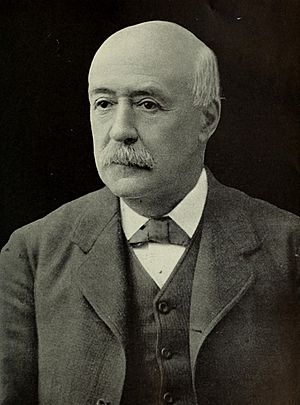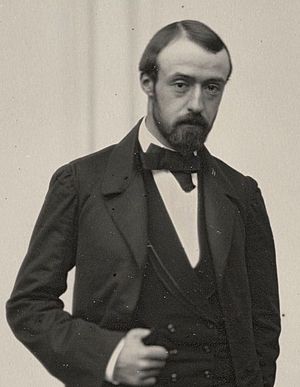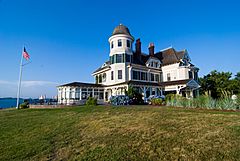Alexander Agassiz facts for kids
Quick facts for kids
Alexander Agassiz
|
|
|---|---|
 |
|
| Born | December 17, 1835 Neuchâtel, Switzerland
|
| Died | March 27, 1910 (aged 74) North Atlantic Ocean (aboard the RMS Adriatic)
|
| Nationality | Swiss, American |
| Alma mater | Harvard University (AB, BS) |
| Children | 3, including Rodolphe Louis Agassiz |
| Parent(s) |
|
| Awards | American Philosophical Society (1862) Pour le Mérite (German order) |
| Scientific career | |
| Author abbrev. (zoology) | A. Agassiz, A. Ag. |
| Signature | |
Alexander Emmanuel Rodolphe Agassiz (December 17, 1835 – March 27, 1910) was a famous American scientist and engineer. He was the son of well-known scientist Louis Agassiz. Alexander made important discoveries about ocean life and helped run a very successful copper mining company.
Contents
Biography
Alexander Agassiz was born in Neuchâtel, Switzerland. He moved to the United States with his parents in 1846. He studied at Harvard University, graduating in 1855. He then learned about engineering and chemistry. In 1857, he earned another degree in science.
Early Work and Discoveries
In 1859, Alexander started working for the United States Coast Survey. This job helped him become an expert in marine ichthyology, which is the study of fish. He was chosen as a member of the American Academy of Arts and Sciences in 1862. Until 1866, he worked as an assistant curator. This was at the natural history museum his father started at Harvard.
Adventures in Copper Mining
A friend of Alexander's brother-in-law found a lot of copper in Michigan. This discovery was at a place called the Keweenaw Peninsula. Alexander and his friends bought a major share in these mines. The mines later became known as the Calumet and Hecla Mining Company. Alexander became the treasurer of this new company.
In late 1866, the copper mining was very difficult. Many people gave up hope, but Alexander did not. He moved to the remote mining town of Calumet in March 1867. He went with his wife and young son. It was a tough time, but Alexander worked hard to make the mines better.
He managed to improve the mining operations. By 1868, he could leave the mines in the care of a general manager. He then returned to Boston. The mines continued to do well. In 1871, several mines joined together to form the Calumet and Hecla Mining Company. Alexander became its president. For many years, this company produced more than half of all the copper in the United States.
Alexander helped the mine succeed in many ways. He installed a huge engine called the Superior. This engine could lift 24 tons of rock from deep underground. He also built a railroad and dug a channel for boats. Thanks to his work, the mines became very profitable.
Returning to Science
After a while, the mines did not need his full-time attention. Alexander returned to his love for natural history at Harvard. He used some of his copper fortune to help Harvard. He gave about $500,000 to the museum of comparative zoology.
In 1873, after his father passed away, Alexander bought land in Newport, Rhode Island. He built a large house and a laboratory there. This was his summer home, finished in 1875. Today, it is known as the Inn at Castle Hill.
Ocean Expeditions and Research
Alexander was the first curator of the Museum of Comparative Zoology (MCZ) from 1874 to 1885. He then became its director until he died in 1910. He went on a scientific trip to South America in 1875. He explored copper mines in Peru and Chile. He also studied Lake Titicaca and collected ancient Peruvian items. He gave these valuable items to the MCZ.
He helped other scientists study collections from the 1872 Challenger expedition. He wrote a detailed report on sea urchins. Between 1877 and 1880, he joined three dredging trips. These trips used the steamer Blake to collect sea creatures from the ocean floor. He wrote two books about these expeditions. In 1875, he also became a member of the American Philosophical Society.
In 1896, Alexander visited Fiji and Queensland. He studied the Great Barrier Reef and wrote a paper about it in 1898. He also wrote books about marine zoology with his stepmother, Elizabeth Cary Agassiz. These included Seaside Studies in Natural History (1865) and Marine Animals of Massachusetts Bay (1871).
Later Life and Honors
In 1902, he received a special German award called the Pour le Mérite for his scientific work. Alexander Agassiz was also the president of the United States National Academy of Sciences. This academy now gives out the Alexander Agassiz Medal in his honor. He passed away in 1910 while traveling on the ship RMS Adriatic.
Alexander and his wife, Anna Russell, had three sons. They were George Russell Agassiz, Maximilian Agassiz, and Rodolphe Louis Agassiz.
Legacy
Alexander Agassiz is remembered in the names of some animals. A type of lizard, Anolis agassizi, and a fish, Leptochilichthys agassizii, are named after him.
A statue of Alexander Agassiz was put up in 1923 in Calumet, Michigan. It is near his summer home where he lived while leading the Calumet and Hecla Mining Company. The Keweenaw National Historical Park now looks after the company's old headquarters, his statue, and other buildings.
See also
 In Spanish: Alexander Agassiz para niños
In Spanish: Alexander Agassiz para niños
- Agassiz family



